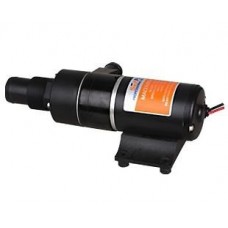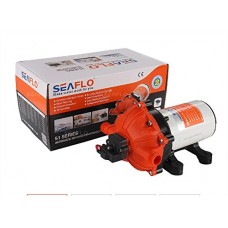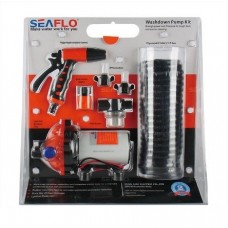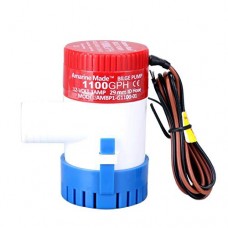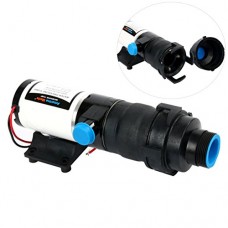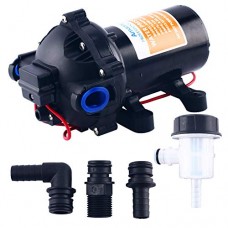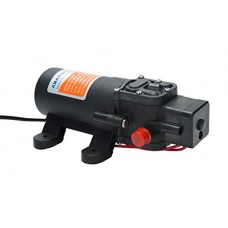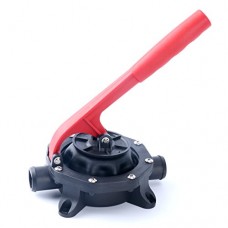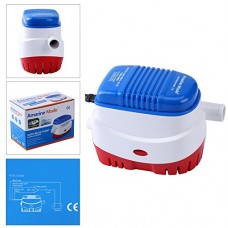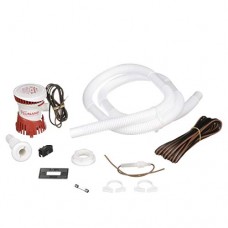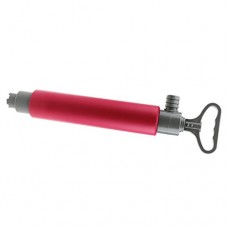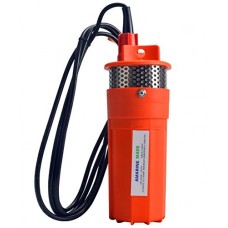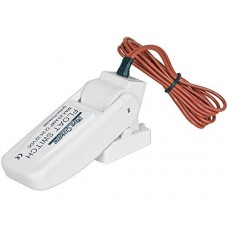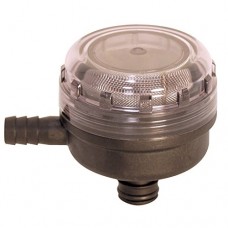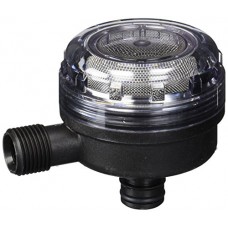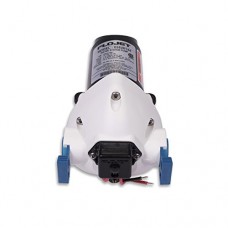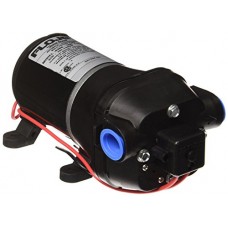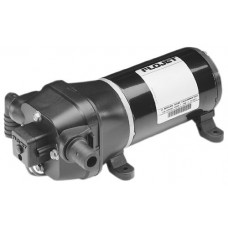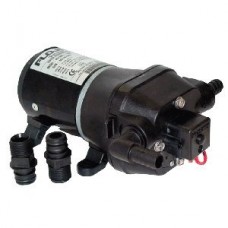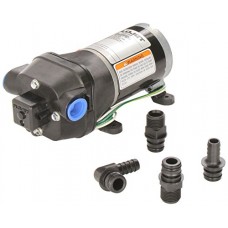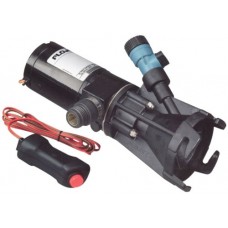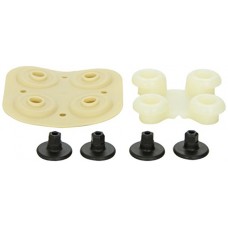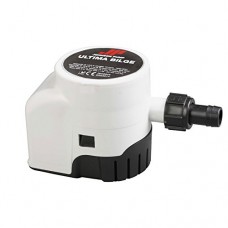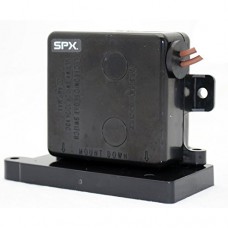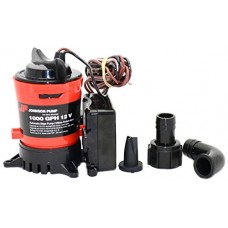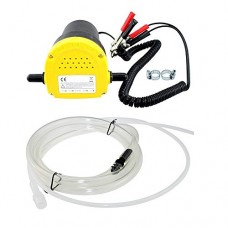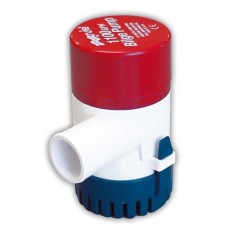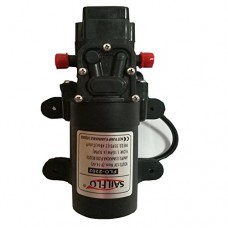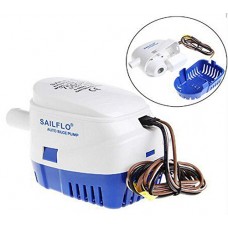Bilge Pumps
Small pumps for separate compartments in boats and other vessels can either be electrically powered or run off of 12v or 24 volt marine batteries. As a rule, every compartment that doesn't allow free flow of water from one to the other needs to have a bilge pump. Smaller boats under 16 feet in length should bilge pumps of at least 800 gallons per hour and more if possible. Boats between 20' and 40' can use bilge pumps or multiple units that should give evacuations of from 2500 GPH to 6000 GPH as the vessel size increases. Buy the largest capacity pumps that will fit your space and ensure hoses and discharges are sized properly.Anyone who does any long range cruising should have an emergency bilge pump.
Diaphragm pumps are re self-priming and act like a wet-vac to draw out bilge water. Water is pulled in through an intake valve, then pushed out through an output valve.
Centrifugal pumps are less expensive but are not self-priming .Advantages include low maintenance, good reliability, and the ability to pass intermediate solids without clogging. They can also run dry for extended periods without immediate damage. They are prone to loss of effectiveness the farther they have to push water vertically.
Amarine-made Marine Boat Bilge Pump Float Switch - White
Application: Use together with our mini-submersible pump, yo..
Sea Flo 12v Macerator Water Waste Pump 45 LPM 12gpm Toilet Rv Trailer Camper Marine Boat
This macerator pump unit is a compact and electrically power..
Seaflo 12v Water Pressure Diaphragm Pump 18.9 L/min 5.0 Gpm 60 Psi - Caravan/rv/boat/marine
Seaflo 12v DC Water Pressure Diaphragm Pump 18.9 L/min 5.0 G..
Seaflo 60 PSI Washdown Deck Wash Pump KIT 12v 5.0 GPM for Caravan Rv Boat Marine Yacht
Introduction: Seaflo's washdown kit includes everything you..
Amarine-made 1100gph 12v Boat Marine Plumbing Electric Bilge Pumps (1100gph 12v)
Features: The Amarine-made submersible bilge pumps are toug..
Amarine-made 12V 45 LPM 12GPM Quick Release RV Mount Macerator Waste Water Pump,Boat RV Marine
FEATURES:-Macerator pump combines a self-priming flexible im..
Amarine-made 12v Water Pressure Diaphragm Pump 18.9 L/min 5.0 Gpm 60 Psi - Caravan/rv/Boat/Marine
Application: Yacht / RV/Caravan pressurized water system, Sp..
Amarine-made 12v Water Pressure Diaphragm Pump 4.3 L/min 1.1 GPM 35 PSI - Caravan/rv/boat/marine
The New Pump have some water inside due to factory test, eve..
Amarine-made 720GPH Manual Hand Bilge Waste Water Transfer Pump
DATA: -Diaphragm hand pump with two position handle;-Self-pr..
Amarine-made Automatic Submersible Boat Bilge Water Pump 12v 750gph Auto with Float Switch-New
Amarine-made automatic bilge pump -750gph Compact, automati..
Attwood Corporation 4614-7 5' Hose with Clamps Bilge Pump Installation Kit
Caution: Bilge pump switches are not external ignition prote..
Bilge Pump for Kayak Raft Safety Kayaking Emergency Water Bailing Pump
You will find what you want in Sports & Outdoors, Home & Kit..
Five Oceans Bilge Pumps for Boats & RVs (Float Switch)
These Five OceansŽ non-mercury heavy duty automatic float sw..
Flojet 01740-012A Inlet Strainer
Flojet 01740-012A Inlet StrainerFlojet 01740-012A Inlet Stra..
Flojet 01740014A 1/2" Pump Strainer
40 mesh (Fine) stainless steel filter screen. Features: Prev..
Flojet 03526 144A Triplex Diaphragm 3526 Series Automatic Water System Pump
Flojet 03526-144A Triplex Diaphragm Automatic Water System P..
Flojet 04306500A 3.2GPM 35 PSI 12V Pump
Brand: Flojet Product Number: 04306-500A Category: Water Pum..
Flojet 04406-143A Multi-Fixture Water Pump
For boats, RVs and more! Choose the pump that's best for you..
Flojet 04406043A 3.2 GPM 35 PSI 110V Quiet Quad Water Pump System
Quiet Quad Water System Pump - 115VAC Features: Intermittent..
Flojet 04406043A 3.3 GPM 35 PSI 110V Quiet Quad Water Pump System
For boats, RVs and more! Choose the pump thats best for your..
Flojet 18555000A Waste Water Pump
Portable RV Waste PumpThe Flojet 18555-000 DC portable waste..
Flojet 20403-040 Diaphragm Kit
Transfer pump for shower and grey water. Runs dry without ha..
Johnson Pump (32-47258-003) 600 GPH Ultima Bilge Pump
Ultima Bilge PumpUltimaBilge Pumps are the latest addition t..
Johnson Pumps Of America 36303 Marine 20 Amp Ultima Auto Bilge Control Switch
Patented Mirus field effect detector cells producing micro-e..
Johnson Pumps of America Ultima Combo Pump 1000 GPH with Du Raports
Johnson Pumps Of America Ultima Combo Pump 1000 Gph With Du ..
Qiilu 12V 60W Oil/Diesel Fluid Sump Extractor
This high efficient fuel pump is an ideal equipment for quic..
Rule 27D 1100 GPH Marine Bilge Pump, Non-Automatic, Submersible, 12 Volt
Rule 1100The Rule 1100 offers impressive pumping power for i..
SAILFLO 12V DC Water Pressure Diaphragm Pump for Caravan RV Boat Marine (35 PSI / 1.0 GPM)
SPECIAL FUNCTIONS: Durable rubber feet for reduced vibrati..
SAILFLO Automatic Bilge Pumps 750 GPH 12V DC All-in-one Marine Submersible Water Pump 4 Year Warranty Boat Auto Yacht RV
Specifications: The SAILFLO submersible auto bilge pumps are..


